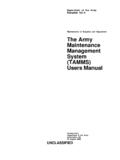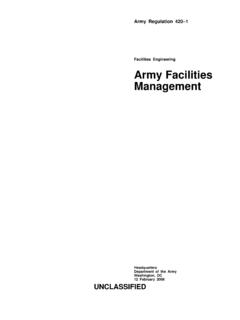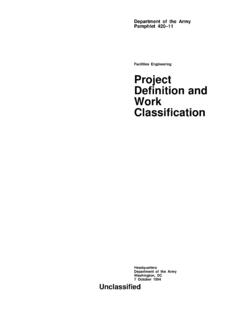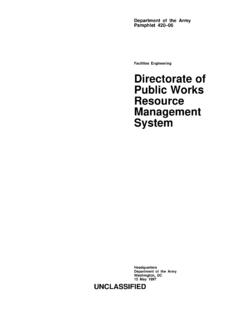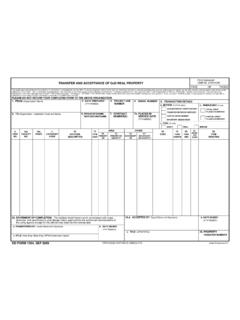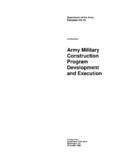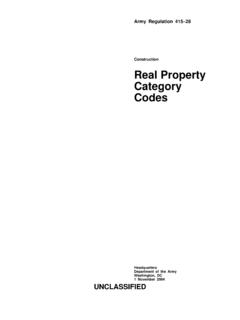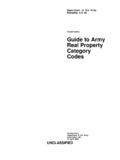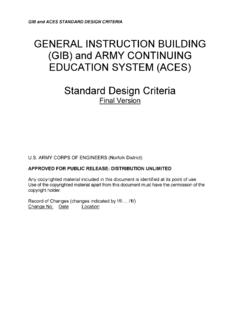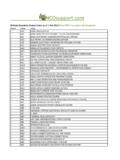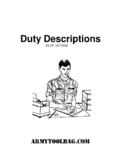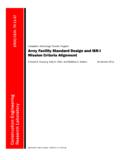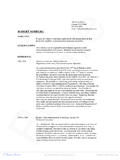Transcription of APPENDIX A - rubiconplanning
1 ETL 1110-3-46626 Aug 94A-1 APPENDIX ASELECTION AND DESIGN OF OIL/WATERSEPARATORS AT ARMY FACILITIESETL 1110-3-46626 Aug 94A-2 TABLE OF CONTENTSSELECTION AND DESIGN OF OIL/WATER SEPARATORSAT ARMY AND of Hardstand Cleaning and scheduling and and cleaning of Sludge and Petroleum vs. Retrofit LAWS AND Statutes and Waste of of Applying to of Waste Oil and of Oil, Petroleum Pollution SpillPrevention Control and Countermeasure Plan .A-19 ETL 1110-3-46626 Aug AND Wastewater and Temperature and vs. OF Concrete and Fiberglass Reinforced Plastic Protective AND MAINTENANCE INFLUENT of and of Equipment and Standby 1110-3-46626 Aug 94A-4 List of Tables and FiguresPageTable 1-1 Permit Requirements for DifferentOperating 2-1 Data Summary of Wastewater 1-1 Sources of 1110-3-46626 Aug 94A-51.
2 INTRODUCTION AND BACKGROUNDThe military is one of the largest purchasers of oil/waterseparators in the United States. The number of separatorscurrently owned and operated by the U. S. Army is in thethousands. A typical installation such as Ft. Carson has inexcess of 150. In recent years, it has become obvious that manyof the separators the military has installed are not performingas anticipated. Inadequacies have often resulted from poordesign, improper selection of pre-manufactured, off-the-shelfunits, failure to adequately understand the character ofwastewaters being treated or pretreated, and lack of maintenance,frequently caused by not providing convenient access to theseparator and its components. The same problems are very commonwith field-constructed Army has historically purchased and installed separatorsunder the assumption that they have only an oil/water separationproblem to solve.
3 However, the most common military applicationsseldom involve simple oil and water mixtures. Waste streamsencountered frequently contain significant quantities of dirt,cleaning aids (detergents, solvents, etc.), fuels, floatabledebris (vegetation, light sticks, etc.), as well as various othermaterials such as ammunition and ammunition casings, bolts,beverage cans and other items common to military equipment widespread failure of oil/water separators in the militaryis frequently the result of improper or inadequate these systems are not designed or installed to provide forconvenient access or maintenance. Many separator designs haveonly manhole access ports, and some have been found installedcompletely below paved surfaces with small access ports.
4 Thesefactors assure that timely and effective maintenance is is common for separators to discharge to one of threelocations: an industrial sewer, a sanitary sewer, or to theenvironment via some portion of the stormwater drainage should be noted that many pre-manufactured separators, andsome field-constructed units designed by engineers, haveprovisions for bypass to stormwater drainage. Differentdischarge locations can place very different effluentrequirements on the separator, with the industrial sewer beingthe most lenient, and the environment the most strict. Thedesigner should know exactly where the separator effluent will begoing, and design for the standards and regulations governingthat particular system. Discharging the most common oil/waterETL 1110-3-46626 Aug 94A-6wastes found on Army installations to the environment willgenerally require that the treatment unit be designed for morethan simple gravity considerations, along with new environmental regulationsand the widespread failure in performance of oil/water separatorsat Army installations, are the impetus for this Sources of WasteThe most common sources of wastewater requiring pretreatmentor treatment for oil or grease separation are associated withvehicle maintenance activities.
5 Within a typical motor pool oraircraft hangar, there are numerous areas which producewastewaters that will require treatment. Wastewaters from thesesources will commonly be intermittent in flow pattern, containgrease, oil and other floating or floatable liquids, floatingdebris, settleable solids including soil, mechanical componentsof vehicles, and other materials having a specific gravitygreater than that of the wastewater. Cleaning aids such asdetergents, solvents, and fuels, will commonly be present. Figure1-1 shows a breakdown of the various areas in which wastes areproduced, as well as particular wastes produced in each area. The"source" is described further by a partial listing of thecontaminants which are frequently present in the wastewater or"runoff.
6 " This ETL in no way covers every possible waste orwaste stream that may enter an oil/water separator. Those listedare only the most common. The designer should always considerwhere the separator is to be placed and what type of waste streamwill be involved. Also, source control should be emphasized tothe greatest extent possible. A discussion of some of theseareas follows. It is critical that the designer understand theprocess generating the wastewater. This requires knowledge ofthe activities, equipment, and procedures being utilized in Hardstand DrainageDrainage from interior and exterior hardstand areas will occurduring "wash down" of the area, from vehicle wet cleaningactivities, spillage or leakage of oil or cleaning agents, andduring a storm event.
7 These activities generally produce awastewater stream consisting of large volumes of water, dirtwhich has accumulated on the hardstand area, and possibly smallquantities of oil from leaking vehicles or overflowing drip Drip CansETL 1110-3-46626 Aug 94A-7 Cans placed under vehicles to capture oil leaks are often leftexposed to rainfall. The oil and water mixture that results isfrequently emptied into an oil/water separator. If unchecked foran extended period, drip cans may overflow and mix with drainagefrom the rest of the hardstand Fueling AreasWaste streams from fueling areas may include fuel as a resultof spills, and dirt and water from the surrounding , troops may clean and flush fuel containers in this and cleaning of fuel transport equipment is a majorsource of wastewaters requiring POL product separation at manyArmy installations.
8 These activities result in large quantitiesof fuel and water entering the waste POL StorageETL 1110-3-46626 Aug 94A-8 POL storage wastes result from spills, leaking containers, andstormwater intrusion. Waste oil and anti-freeze, normally storedin 55 gal drums, are the two most common substances found in POLstorage areas. Often, these waste drums are stored withoutadequate protection from rainfall. Stormwater can then intrude,overflow the drums, and the resulting mixture will enter thedrainage Grease RacksGrease racks allow vehicles to be elevated for inspection andmaintenance purposes. Maintenance performed typically involvesradiator repairs, lubrication and oil changes. These processesmay result in spilled anti-freeze and oil.
9 Storm water will alsocontribute to the waste stream as most elevated grease racks Floor DrainsDrainage from floor drains in an indoor maintenance bay orhangar would typically result from either wet cleaning of thefloor, wet maintenance cleaning of mechanical areas on vehicles,or spills. Oils and solvents are the most common substancesspilled. Residuals of these spills, along with "oil-sorb" (bothnew and used) and dirt, will enter drains when the floors arecleaned. Also, detergents used by the troops to assist incleaning will enter the drainage WashracksPerhaps the most likely areas in which to find oil/waterseparators are vehicle washracks. Wastes produced from thewashing process include water, dirt from the exterior ofvehicles, oil that has spilled or leaked onto vehicle exteriorssurfaces, lubricants and other fluids from the interior, variousfloating debris resulting from poor housekeeping, and detergentsused in the cleaning Vehicle Cleaning and Tactical VehiclesMost major Army installations require maintenance and repairon large numbers of tactical vehicles.
10 An important element ofArmy vehicle maintenance (both land and air) is interior andexterior cleaning. The exterior of a vehicle must be clean forinspection purposes, locating leaks or damaged parts, and to makenecessary repairs. Many Army installations have central vehicleETL 1110-3-46626 Aug 94A-9wash facilities which provide for exterior cleaning of tacticalland vehicles. Even with central vehicle wash facilities , it iscommon for many installations to allow individual battalion andother motorpools to retain exterior washing facilities within themotor pool area. These are frequently used for both maintenanceand exterior "final or cosmetic cleaning". Motorpool washracks,as stated earlier, are a very common location for on tracked vehicles includes both interior andexterior washing, and lubricating fluid (POL) changes.
